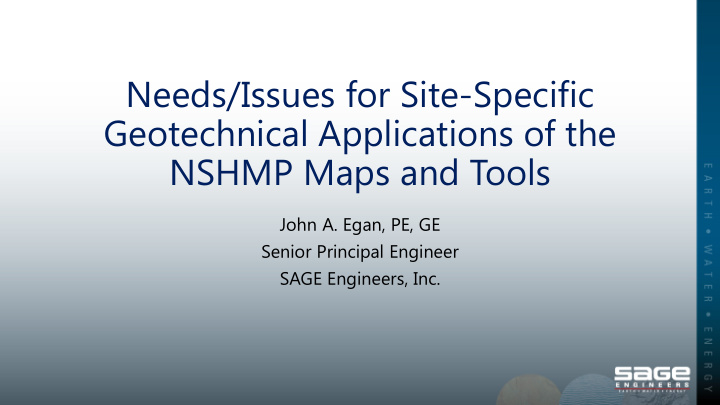



Needs/Issues for Site-Specific Geotechnical Applications of the NSHMP Maps and Tools John A. Egan, PE, GE Senior Principal Engineer SAGE Engineers, Inc.
Issues Addressed • Accessing the NSHMP information • Targeted-risk-free design maps • Spectral shape • Site Response Considerations
Accessing the NSHMP information 2008 Interactive Deaggregation Hazard curve application
…accessing the NSHMP information U.S. Seismic Design Maps Risk Targeted Ground Motion Calculator
…accessing the NSHMP information Interactive Quaternary Fault and Fold Database of the United States UCERF3 - The Future
Targeted-risk-free design maps/tool Reasons: • Don’t mix risk into hazard • Numerous types of structures, other than generic buildings • Different risk targets and fragility relationships may be appropriate • Period-dependent risk coefficients • Site Class-dependent risk coefficients • Comparison of NSHMP results to site-specific hazard assessments Suggestions • Allow user to choose whether or not hazard results include the risk-targeted factors • Separate, but parallel map tool
Targeted-risk-free design maps/tool
Spectral Shape What many geotechnical What he/she neglects to consider… engineers grab and report
Spectral Shape ….and
Spectral Shape Multi-period USGS UHRS & site-specific deterministic spectra • Longer-period spectral ordinates for SFFB site are substantially higher than MCE R spectrum from USGS Design Map Tool • Results from effects of larger magnitude events dominating hazard and Site Class/V S30 • In EUS, converse magnitude effect may occur at many locations Suggestion • indicator in the U.S. Seismic Design Map tool could be triggered to alert a user that the hazard deaggregation and/or Site Class for the site indicate that such effects are a possibility and should be examined by the user
Site response considerations Site Class F a & F v –vs- V S30 effects
Site response considerations Non-standard V S profiles – Washington, D.C., National Mall
Conclusions • NSHMP provides valuable seismic hazard information • Useful comparison for site-specific assessments • USGS Design Map Tool is easy to use • ………..and easy to misuse • Users need to look deeper than the surface Targeted-risk Spectral shape Site Response Considerations
Recommend
More recommend